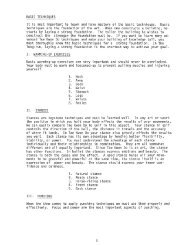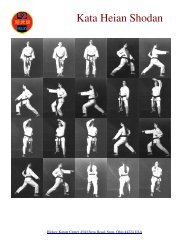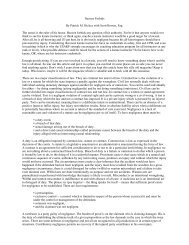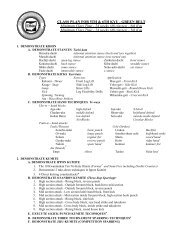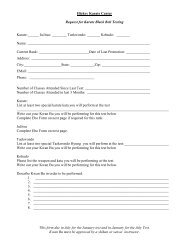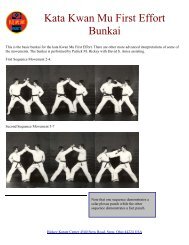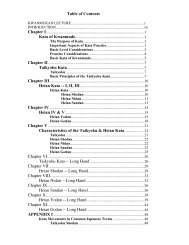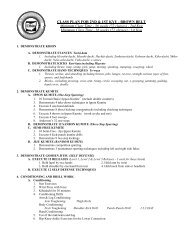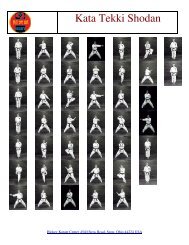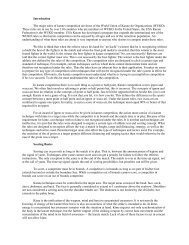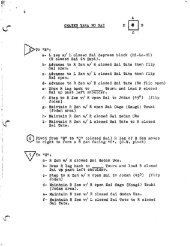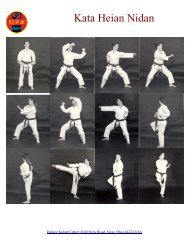OTKA Judo Guide - Hickey Karate Center
OTKA Judo Guide - Hickey Karate Center
OTKA Judo Guide - Hickey Karate Center
- No tags were found...
Create successful ePaper yourself
Turn your PDF publications into a flip-book with our unique Google optimized e-Paper software.
Table of Contents<strong>Judo</strong> .................................................................................................................................3 Ranking System..............................................................................................................3 <strong>Judo</strong> Technical Divisions...............................................................................................3 Parts of a Throw.............................................................................................................4 Falling Methods..............................................................................................................5 <strong>Judo</strong> Techniques ............................................................................................................8 Throwing - Nage Waza......................................................................................8 Hand Techniques - Te Waza ..................................................................8 Hip or Loin Techniques - Koshi Waza...................................................8 Foot & Leg Techniques - Ashi Waza .....................................................8 Rear Fall and Side Fall Throws - Matsutemi Waza & Yokosutemi Waza8 Holds and Escapes - Katame-Waza or Ne Waza ............................................8 Pinning Techniques - Osaekomi-waza...................................................8 Strangle or Neck Lock Techniques - Shime-waza.................................8 Joint Techniques - Kansetsu-waza.........................................................8 Attacking the Vital Points of the Body - Ate-Waza (Atemi Waza) ...............9 Kwanmukan <strong>Judo</strong> Requirements For 5th and 6th Kyu.............................................10 General Requirements.......................................................................................10 Grips and Grip Breaking ..................................................................................10 Ukemi Waza .......................................................................................................10 Throws - Nage Waza..........................................................................................10 Grappling............................................................................................................10 Defense Against Throws....................................................................................10 Notes................................................................................................................................11 General Requirements.......................................................................................11 Grips and Grip Breaking ..................................................................................11 Ukemi Waza .......................................................................................................11 Throws - Nage-Waza .........................................................................................11 Grappling............................................................................................................11 Defence Against Throws....................................................................................12 Kwanmukan <strong>Judo</strong> Requirements For 4th Kyu...........................................................13 General Requirements.......................................................................................13 Grips and Grip Breaking ..................................................................................13 Throws - Nage Waza..........................................................................................13 Defense Against Throws....................................................................................13 Counters For Throws ........................................................................................13 Grappling............................................................................................................13 Entry Into Grappling.........................................................................................13 Kwanmukan <strong>Judo</strong> Requirements For 3rd Kyu ..........................................................14 Grips and Grip Breaking ..................................................................................14 Throws - Nage Waza..........................................................................................14 Defense Against Throws....................................................................................14 Counters For Throws ........................................................................................14 Combinations of Throws ...................................................................................14
Table of ContentsGrappling............................................................................................................14 Entry Into Grappling - Hairi Kata...................................................................14 Kwanmukan <strong>Judo</strong> Requirements For 2nd Kyu..........................................................15 Grips and Grip Breaking - Kumi Kata............................................................15 Throws - Nage Waza..........................................................................................15 Defense (Bogyo) Against Throws......................................................................15 Counters (Kaeshi) For Throws.........................................................................15 Combinations (Renraku) of Throws ................................................................15 Grappling - Osaekomi .......................................................................................15 Entry Into Grappling.........................................................................................15 Grappling - Shimewaza .....................................................................................15 Kwanmukan <strong>Judo</strong> Requirements For 1st Kyu ...........................................................16 Grips and Grip Breaking - Kumi Kata............................................................16 Throws - Nage Waza..........................................................................................16 Defense (Bogyo) Against Throws......................................................................16 Counters (Kaeshi) For Throws.........................................................................16 Combinations (Renraku) of Throws ................................................................16 Grappling - Osaekomi .......................................................................................16 Entry Into Grappling.........................................................................................16 Grappling - Shimewaza .....................................................................................16 Grappling - Kansetsuwaza................................................................................16 Kwanmukan <strong>Judo</strong> Requirements For 1st Dan............................................................18 Throws - Nage Waza..........................................................................................18 Throws - Nage Waza..........................................................................................18 <strong>Judo</strong> Kata Listing...........................................................................................................20 <strong>Judo</strong> Drills ......................................................................................................................20 Go Kyo No Waza............................................................................................................21 1st Kyo (Dai Ikkyo) of the Go Kyo No Waza ..................................................21 2nd Kyo (Dai Nikyo) of the Go Kyo No Waza ................................................21 3rd Kyo (Dai Sankyo) of the Go Kyo No Waza ..............................................22 4th Kyo (Dai Yonkyu) of the Go Kyo No Waza ..............................................22 5th Kyo (Dai Go Kyo) of the Go Kyo No Waza ..............................................23 Shinmeisho No Waza .........................................................................................23 Notes for Clinic...............................................................................................................26 Copyright © 1990 Patrick M. <strong>Hickey</strong>Published by the KwanmukanPrinted 8/24/10
Kwanmukan <strong>Judo</strong><strong>Judo</strong><strong>Judo</strong> was founded in 1882 by Dr. Jigoro Kano as a refinement to the martial art of Jujitsu.Dr. Kano’s school was called the Kodokan -- Ko means "to preach", do means "way or path" andkan means "hall" or "training hall" Referred to as the "gentle way", <strong>Judo</strong> uses the flexible orefficient use of balance, leverage and momentum. Skill and timing rather then brute force is thehallmark of good <strong>Judo</strong> technique and is brought out in Dr. Kano's two maxims. The first maxim- "seiroku zenyo (maximum efficiency)" - means optimal use of mental and physical energy."Jita kyoei (mutual welfare and benefit)", the second maxim, refers to the consideration ofothers. Literally translated, "You and I shining together." The idea of give and take in practiceis to help each other learn through cooperation. From this we learn to manage our lives and timeefficiently and effectively and build the character to be good citizens and help our follow man.This final aim or goal of <strong>Judo</strong> Dr. Kano called, "The harmonious development and eventualperfection of human character." Dr. Kano tried to get <strong>Judo</strong> to be an Olympic sport but died in1938 before accomplishing this. It was not until 1964 that <strong>Judo</strong> made the Olympics and Olympicwomen's' competition did not begin until 1988.What is Ju? Ju is gentleness or giving away. Gentleness means giving away until theright moment arrives. <strong>Judo</strong> teaches maximum physical use of mental and physical energy.Force is necessary in <strong>Judo</strong> and is applied (added to) your opponent's force. You do not move inresistance to the opponent's force. Do not move harshly, as your movement should be gentle andin harmony with your opponent's. You do not move harshly. By doing this you can take a forceof 5 and add to it. The gentleness is your movement, not what happens to your opponent.Ranking SystemThe usual <strong>Judo</strong> rank system is divided between Junior Ranks (under 17) and SeniorRanks (17 and over). There are 12 degrees of junior ranks - 2 each of yellow, orange, green,blue, purple, and brown. Senior Ranks have 6 Kyu grades - yellow, orange, green, and 3 browns.There are 10 dan grades or black belts with 6 & 7 dan wearing red & white belts, and 9 & 10 danwearing red belts.<strong>Judo</strong> Technical DivisionsThere are 3 divisions of <strong>Judo</strong> techniques: throwing techniques, (nage-waza), grappling orholding techniques (katame-waza or newaza), and body-blow techniques (atemi-waza). Nagewazarefers to throwing techniques created by using momentum (hazumi) or impetus (ikioi).Throwing techniques are divided into standing techniques (tachi-waza) or falling techniques(sutemi-waza). In tachi-waza there are hand (te-waza), hip (koshi-waza), and foot (ashi-waza)techniques. In falling techniques there are rear (matsutemi-waza) and side (yoko sutemi-waza)falls. Throws can also be referred to as sweeping (barai or harai), reaping or clipping (gari),hooking (gaki), wheels (guruma), drops (otoshi - must get center of body outside its base), lifting(tsuri), reversals (gaeshi), and winding (makikomi). Most throws will follow one of these threepatterns: hold the top and sweep out the bottom, hold the bottom and tip over the top, or rotatearound the middle moving the top and bottom outside of the base.In katame-waza we find three types of techniques, pinning (osaekomi-waza), strangle(shime-waza), and joint techniques (kansetsu-waza). Escaping from a hold is called fusegi.Atemi-waza includes both arm (ude-ate) and leg (ashi-ate) strikes.3
Kwanmukan <strong>Judo</strong>The name of a judo technique is taken from the part of the body that is most apparentfrom the actual execution of the technique. As a general rule, names for <strong>Judo</strong> techniques fall intonames that describe the action, names that contain the part of the body used, those that indicatethe direction in which to throw the opponent, and those that describe the feeling of the technique.Self Defense in <strong>Judo</strong> is referred to as Goshin-jitsu. Free practice is referred to as randori.Other concepts are important to understand. Basic postures or stances in <strong>Judo</strong> include theShizen-tai - natural position, right (migi) natural position, left (hidari) natural position and theJigo-tai - self-defense position, right self-defense position, and left self-defense position.Standing together is called kumikata and includes how to hold onto the opponent. Bodymovement is called shintai (advance-retreat), which includes tsugi-ashi walking or tai-sabiki ,which is the way our body is manipulated and controlled. This includes how we carry the head,use the eyes, control our breathing, use our torso, move our hands and move our feet.<strong>Judo</strong> explores the concept of push-pull. This <strong>Judo</strong> concept can be stated thusly:First push, relax the force then pull.First pull, relax the force then push.If you find that you can neither push or pull, raise your opponent up. These basics concept in<strong>Judo</strong> can be also be performed by pulling when your opponent pushes or by pushing when youropponent pulls. Another way of expressing this idea is if pushed, turn to the side away from thepush; if pulled, move diagonally forward of the direction of the pull (this is Mifune'scontribution.) You will find that timing is important. Acting too soon or too late will only helpyour opponent. Generate force by concentrating all your energy in the spot where you need it atthe right time. You must break your opponents posture before you enter into the throw. This iscalled kuzushi. You can easily break posture/balance by pushing him when he pulls and pullingwhen he pushes.Parts of a ThrowThere are three parts to the <strong>Judo</strong> throw: off-balancing (kuzushi), entry (tsukuri) andexecution (kake). Jigoro Kano became famous because he discovered the rule of kuzushi -hsing. With a minimum amount of strength it is possible to throw your opponent if you forcehim off balance, that is break his posture. Kuzushi is the breaking of the opponent's balance.There are 8 basic directions in which to break the opponent's balance (happo no kuzushi).Tsukuri is the preparatory movement for the attack. It includes getting both your body and youropponent’s body into a position where the opponent can be easily thrown. While continuing tokeep your opponent off balance, you place your body in the best position from which to executean attack. The attack is the execution (kake) of the throw. Throw in the direction the opponentis moving. The direction of his head can also be useful since it is heavy and the body tends tofollow the head. Do not throw until you do both kuzushi and tsukuri.How to apply a <strong>Judo</strong> throwReaction time is that time required to respond to outside stimuli. Your opponent hasreaction time. Harmonizing your movement with that of your opponent allows you to takeadvantage of his reaction time. Using sensory perception, you can maintain awareness ofopponent’s position or change in position. By creating an unguarded moment, you can set upand take advantage of any reaction time. The unguarded moment is set up by breaking posture(zanshin) of your opponent before he can react. You must do this in the transition of youropponent’s movement to yours - his reaction time. The longer the reaction time, the harder it is4
Kwanmukan <strong>Judo</strong>for the opponent to respond and the more effective you will be. To take advantage of this, youmust move faster and farther then your opponent and be able to get back into a neutral positionbefore a counterattack can take place.Falling MethodsFalling methods (ukemi-waza, which means falling away) include falling to the rear,falling to the front, forward roll-out, falling to either side, back somersault, back shoulder roll,forward shoulder roll, cartwheel, etc.5
Kwanmukan <strong>Judo</strong><strong>Judo</strong> Questionnaire1. Name the three parts of a <strong>Judo</strong> throw.2. What three divisions of empty hand fighting are found in <strong>Judo</strong>?3. What are the two divisions of nage-waza?4. Name the three divisions of tachi-waza.5. Name the three divisions of katame-waza.6. Name the two divisions of sutemi-waza.7. What are the two principles of Kodokan <strong>Judo</strong> as defined by Dr. Jigoro Kano?8. What is the ultimate goal of <strong>Judo</strong> as defined by Dr. Jigoro Kano?9. What are the grade belts in <strong>Judo</strong> leading to Black Belt?10. What is the name of the kata required for Shodan and how many throws does it have?11. Who is Dr. Jigoro Kano and what did he found in Japan for <strong>Judo</strong>?12. What does Jumean?13. What does Ko-do-kan mean?14. When did <strong>Judo</strong> become an Olympic sport for men? Women?15. How are <strong>Judo</strong> throws named?16. Explain the concept of push-pull.17. What is reaction time?18. What is George E. Anderson's <strong>Judo</strong> rank?19. What is the unguarded moment?20. What <strong>Judo</strong> organization does he support?Vocabulary Match1. Kuzushi A. Standing techniques2. Tsukuri B. Side falling techniques3. Kake C. Off-balancing4. Ukemi-waza D. Escaping5. Nage-waza E. Self defense position6. Atemi-waza F. Foot strikes7. Katame-waza G. Grappling8. Hazumi H. Reaping9. Ikioi I. Grappling or holding techniques10. Tachi-waza J. Hip techniques11. Sutemi-waza K. Execution12. Te-waza L. Arm strikes13. Koshi-waza M. Hand techniques14. Ashi-waza N. Dropping15. Masutemi-waza O. Sweeping16. Yoko sutemi-waza P. Left17. Harai (barai) Q. Falling techniques18. Gaki R. Impetus19. Gaeshi S. Strangling techniques20. Gari T. Foot techniques21. Guruma U. Hooking22. Otoshi V. Momentum23. Makikomi W. Right24. Osaekomi-waza X. Wheel25. Shime-waza Y. Reversal26. Kansetsu-waza Z. Throwing techniques27. Fusegi AA. Standing/gripping techniques28. Kumikata BB. Winding29. Ude ate CC. Body blow techniques30. Ashi ate DD. Back falling techniques31. Migi EE. Entry32. Hidari FF. Side falling techniques6
Kwanmukan <strong>Judo</strong>33. Shizen tai GG. Joint techniques34. Jigo tai HH. Natural posture35. Randori II. Free practice7
Kwanmukan <strong>Judo</strong><strong>Judo</strong> TechniquesThrowing - Nage WazaHand Techniques - Te WazaTai Otoshi - Body Drop Uki Otoshi - Floating Drop Isumi Otoshi - Corner DropIppon Seoinage - One ArmBack Carry or ShoulderthrowSeoinage/Morote Seoinage -Two Hand Back Carry orShoulder ThrowKata Guruma - Shoulder Wheelor WhirlHip or Loin Techniques - Koshi WazaO Goshi - Major Hip Hane Goshi - Springing Hip Uki Goshi - Rising HipUshiro Goshi - Rear Hip Harai Goshi - Hip SweepTsuri Komi Goshi - Lift andPull HipKoshi Guruma - Hip Wheel orWhirlOsoto Guruma - Big or MajorOutside Wheel or WhirlFoot & Leg Techniques - Ashi WazaKouchigari - Small or MinorInside ReapDe Ashi Barai - Forward orAdvance Foot SweepUchimata - Inner Thigh Osoto Guruma - Big or MajorThrowOutside Wheel or WhirlSasae Tsurikomi Ashi - Lift Kosotogari - Small or Minorand Pull Foot Prop Outside Reap (clip)Okuri Ashi Harai - Sweeping Hiza Guruma - Knee WheelAnkleAshi Guruma - Leg Wheel orWhirlOsotogari - Big or MajorOutside ReapOuchigari - Big or Major InsideReapRear Fall and Side Fall Throws - Matsutemi Waza & Yokosutemi WazaTomoe Nage - Circle, Ura Nage - Inside Out or Rear Sumi Gaeshi - Corner ReversalStomach or RoundThrowThrowUki Waza - Floating Throw Uchimakikomi - Inner WindingThrowYoko Guruma - Side Wheel orWhirlYoko Otoshi - Side Drop Tani Otoshi - Valley Drop Yokogake - Side Hook or DashHolds and Escapes - Katame-Waza or Ne WazaPinning Techniques - Osaekomi-wazaKesa Gatame - Scarf Hold Kata Gatame - Shoulder HoldKamishiho Gatame - Upper 4 Yokoshiho Gatame - Side 4Corner HoldCorner or 4 Direction HoldStrangle or Neck Lock Techniques - Shime-wazaHadaka Jime - Naked Kata Juji Shime - Single CrossStrangleStrangleKataha Jime - One Wing or Arm StrangleJoint Techniques - Kansetsu-wazaUde Gatame - Arm Lock Juji Gatame - Cross Hold orHold or WrapLockAshi Garami - Entangled Leg Ude Garami - Entangled or BentHold or LockArmlock Hold or WrapGyaku Juji Shime - ReverseCross StrangleWaki Gatame - Armpit Hold orLockHiza Gatame - Knee Hold orLock8
Kwanmukan <strong>Judo</strong>Attacking the Vital Points of the Body - Ate-Waza (Atemi Waza)Strikes and targets are shown but not really practiced in <strong>Judo</strong> as they are in karate. Both ude (arm)and ashi (foot or leg) techniques are found mainly in the self-defense forms taught.9
Kwanmukan <strong>Judo</strong>Kwanmukan <strong>Judo</strong> Requirements For 5th and 6th KyuGeneral RequirementsLevelShizen Hantei Natural Posture 6thJigo Hantei Basic Defensive Posture 6thTsugi Ashi Walking by sliding one foot behind 5thAyumi ashi Normal walking 5thHappo no kuzushi Forms of off balancing (eight) 5thAnza Sitting Cross-legged 5thGrips and Grip BreakingSleeve Grip Swinging arm break through 5thSleeve Grip Swinging elbow break through 5thUkemi WazaSide Falls Yoko Ukemi 5thFront rolling falls Kaiten Zempo Ukemi 5thFront Falls Zempo Ukemi 5thBack Falls Koho Ukemi 5thThrows - Nage WazaName English Reference GoKyo No WazaHiza Guruma Knee Wheel Throw Dai Ikkyo 6thOgoshi Major Hip Throw Dai Ikkyo 6thSeoi Nage Shoulder Throw Dai Ikkyo 6thMorote Seoinage Two Hand Shoulder Throw -------- 6thOsotogari Major Outside Reap Dai Ikkyo 6thDe Ashi Harai Advance Foot Sweep Dai Ikkyo 5thOuchi Gari Major Inside Reap Dai Ikkyo 5thUki Goshi Floating Hip Dai Ikkyo 5thSasae Tsuri Komi Ashi Lifting Pull Foot Prop (trip) Dai Ikkyo 5thGrapplingName English Reference Escape - FusegiKesa Gatame Scarf or Head Hold Bridge and roll escape 6thYokoshiho Gatame Side Four Corner Hold Leg entangling escape 6thKamishiho Gatame Smothering Hold or Locking Single roll escape5thof upper four quartersKuzure Kesa Gatame Modified or variant Scarf orHead HoldUphill turn escape5thHiza GurumaOgoshiDefense Against Throws5th5th10
Kwanmukan <strong>Judo</strong>Shizen HanteiJigo HanteiTsugi AshiAyumi ashiHappo no kuzushiAnzaNotesGeneral RequirementsBasic natural standing posture. Also migi-shizen-tai and hidari-shizen-tai.Basic defensive posture. Lower hips and feet spread wider then shizen tai. Also migi-jigotaiand hidari-jigo-tai.Walking by sliding one foot behindNormal WalkingEight Forms of Off-balancingSitting Cross-leggedSleeve GripSleeve GripGrips and Grip BreakingSwing arm down and then up on the outside. Force down against wrist forcing hand off.Drive elbow up forcing opponents arm up.Side FallsUkemi WazaFront Rolling FallsFront FallsBack FallsTechniqueHiza GurumaDrivingHandLockingHandThrows - Nage-WazaAttacking Driving Leg Hips Head Angle ofLegAttackOgoshiSeoi NageMoroteSeoinageOsotogariDe AshiHaraiOuchi GariUki GoshiSasae TsuriKomi AshiKesa GatameGrapplingHold one arm against side above elbow, reach other hand around neck and grab collar,bend head against opponent's head, feet spread apart. Defenders head must be controlled,11
Kwanmukan <strong>Judo</strong>keep high shoulder down and squeeze your arms in. Chest on chestYokoshiho GatameKamishiho GatameKuzure Kesa GatameAt right angle to opponent, reach thru legs and grab belt thumbs inside , other hand behindneck and hold collar, chest presses on side, knees up to body, use head to stop from goingover in escape attempt by touching or putting the head on the mat or floor.Upper 4 corner holding - reach under the arms and hold belt with thumbs inside, instep flatto the floor, arch back so that stomach presses into the head. Spread feet, toes up and keephead on bellySimilar to kesa gatame but hold shoulder down with hand and head is up. Used whenopponent tries to roll to his side. Called modified scarf hold. Can also reach under armpitand grace the floor.Hiza GurumaDefense Against ThrowsOgoshi12
Kwanmukan <strong>Judo</strong>Kwanmukan <strong>Judo</strong> Requirements For 4th KyuGeneral RequirementsLevelTai Sabaki 90° and 180° pivoting 4thGrips and Grip BreakingCollar Grip Drive through break 4thInner Sleeve Grip For collar grip 4thThrows - Nage WazaName English Reference GoKyo No WazaKouchigari Minor Inside Reap Dai Nikyo 4thKoshi guruma Hip Wheel Dai Nikyo 4thKosotogari Minor Outside Reap Dai Nikyo 4thTsurikomigoshi Lift pull Hip throw Dai Nikyo 4thOsotogariSeoinageOuchigariDeashiharaiDefense Against Throws4th4th4th4thCounters For ThrowsHiza guruma4thOgoshi Tani Otoshi 4thOsotogari4thSeoinage4thGrapplingName English Reference Escape - FusegiYokoshiho Gatame Side 4 corner hold Bridge and roll escape 4thKamishiho Gatame Upper 4 corner hold Double Bridge and Roll Escape 4thKuzure Yokoshiho Modified Side Four Corner4thGatameKuzure KamishihoGatameHoldModified Smothering Hold orLocking of upper four quartersEntry Into GrapplingHalf Nelson Reverse4thHalf Nelson From the Tani Otoshi4thSideBy hooking the legs Break opponent down for a choke 4th4th13
Kwanmukan <strong>Judo</strong>Kwanmukan <strong>Judo</strong> Requirements For 3rd KyuGrips and Grip BreakingLevelLow Lapel Grip Snap out break through 3rdHigh Lapel Grip Inner sleeve counter grip 3rdThrows - Nage WazaName English Reference GoKyo No WazaOkuriashi harai Sliding double foot sweep Dai Nikyo 3rdHarai Goshi Sweeping hip or loin Dai Nikyo 3rdTai Otoshi Body drop Dai Nikyo 3rdUchimata Inner thigh Dai Nikyo 3rdUki GoshiSasaetsurikomiashiKouchigariKoshigurumaOuchigariDeashibaraiUkigoshiSasaetsurikomiashiDefense Against ThrowsCounters For Throws3rd3rd3rd3rd3rd3rd3rd4thCombinations of ThrowsOuchi To Ogoshi 3rdKouchigari To Seoinage 3rdSeoinage To Kouchigari 3rdGrapplingName English Reference Escape - FusegiKata Gatame Shoulder hold Leg over escape 3rdUshiro Kesa Gatame Backward cross chest hold Upper turn escape 3rdKesa Gatame Cross chest hold Sit-up escape 3rdEntry Into Grappling - Hairi KataPushing legs aside3rdGrasp Opponents sleeve pull him around 3rd14
Kwanmukan <strong>Judo</strong>Kwanmukan <strong>Judo</strong> Requirements For 2nd KyuGrips and Grip Breaking - Kumi KataLevelDouble sleeve grip double sleeve counter grip 2ndHigh lapel grip Pull down break through 2ndThrows - Nage WazaName English Reference GoKyo No WazaKosotagake Minor outside dash or breaking Dai Sankyo 2ndTsuri Goshi Pulling/Lifting hip Dai Sankyo 2ndHaraitsurikomiashi Sweeping foot stop Dai Sankyo 2ndHane Goshi Springing hip Dai Sankyo 2ndOkuriashiharaiHarai GoshiTaitoshiUchimataKouchigariKoshigurumaOkuriashiharaiHaraigoshiDefense (Bogyo) Against ThrowsCounters (Kaeshi) For Throws2nd2nd2nd2nd2nd2nd2nd2ndCombinations (Renraku) of ThrowsHizaguruma To sweeping foot technique on opposite side and reverse 2ndSasaetsurikomiashi To sweeping foot technique on opposite side and reverse 2ndHaraigoshi To osotogari on the opposite side and reverse 2ndGrappling - OsaekomiName English Reference Escape - FusegiTateshiho gatame Vertical 4 corner hold Leg out escape 2ndYokoshiho gatame Side 4 corner hold Uphill turn escape 2ndEntry Into GrapplingDouble belt entry2ndsumigashi takedown2ndSommersault entry into newaza 2ndGrappling - ShimewazaName English Reference Escape - FusegiHadaka jime Naked strangle 2ndOkurieri jime Sliding lapel strangle 2ndKataha jime One side strangle 2nd15
Kwanmukan <strong>Judo</strong>Kwanmukan <strong>Judo</strong> Requirements For 1st KyuGrips and Grip Breaking - Kumi KataLevelJacket end grip Circling in arm counter 1stSleeve and Lapel grip Ude gatame break 1stLapel grip Wakegatame break 1stThrows - Nage WazaName English Reference GoKyo No WazaYoko otoshi Sideways drop Dai Sankyo 1stKata guruma Shoulder wheel Dai Sankyo 1stTomoe nage Somersault or Stomach Throw Dai Sankyo 1stAshi guruma Leg wheel Dai Sankyo 1stKosotogakeTsurigoshiHaraitsurikomiashiHane goshiTaiotoshiUchimataKosotogakeTsurigoshiDefense (Bogyo) Against ThrowsCounters (Kaeshi) For Throws1st1st1st1st1st1st1st1stCombinations (Renraku) of ThrowsForward throw Forward throw on opposite side 1stUchimata To Kouchigari and the reverse 1stUchimata To Ouchigari and the reverse 1stGrappling - OsaekomiName English Reference Escape - FusegiKamishiho gatame Upper four corner hold Uphill turn escape 1stKamishiho gatame Upper four corner hold Double arm escape 1stKamishiho gatame Upper four corner hold Press out escape 1stKamishiho gatame Upper four corner hold Legs over escape 1stHolding opponents legs togetherKnee in entryEntry Into Grappling1st1stGrappling - ShimewazaName English Reference Escape - FusegiNamijuji jime Natural cross strangle 1stKatajuji jime Half cross strangle 1stGyakujuji jime Reverse cross strangle 1stGrappling - KansetsuwazaName English Reference Escape - Fusegi16
Kwanmukan <strong>Judo</strong>Juji gatame Cross arm lock 1stUde gatame Arm lock 1stUde garami Entangled arm lock 1st17
Kwanmukan <strong>Judo</strong>Kwanmukan <strong>Judo</strong> Requirements For 1st DanThrows - Nage WazaName English Reference GoKyo No Waza GradeSumigaeshi Corner throw Dai Yonkyo 1stTani Otoshi Valley drop Dai Yonkyo 1stHane MakikomiWinding spring hip or CrescentDai Yonkyo 1stwindingSukuinage Scoop throw Dai Yonkyo 1stUtsurigoshi Changing hip throw Dai Yonkyo 1stOguruma Major Wheel Dai Yonkyo 1stSotoMakikomi Outer winding throw Dai Yonkyo 1stUki Otoshi Floating drop Dai Yonkyo 1stThrows - Nage WazaName English Reference GoKyo No Waza GradeOsotoguruma Major outer leg wheel Dai Gokyu 1stUkiwaza Floating technique Dai Gokyu 1stYokowakare Side avoiding Dai Gokyu 1stYokoguruma Side wheel Dai Gokyu 1stUshirogoshi Back hip Dai Gokyu 1stUra nage Back Throw Dai Gokyu 1stSumiotoshi Corner drop Dai Gokyu 1stYokogake Side Hook Dai Gokyu 1stDemonstrate Nage-no-kata - First Nine TechniquesNage No KataAttack Grip Throw FallTewazaUko OtoshiSeoinageKata gurumaKoshiwazaUki goshiHarai goshiTsurikomi goshiAshiwazaOkuri ashi haraiSasae Tsurikomi ashiUchimataMatsutemiwazaTomoe nageUra nageSumi gaeshi18
Kwanmukan <strong>Judo</strong>YokosutemiwazaYoko gakeyoko gurumaUkiwazaAll general information and vocabularyAll prior techniquesProper time in grade19
Kwanmukan <strong>Judo</strong><strong>Judo</strong> Kata ListingNage-no-kata Formal Techniques of Throwing To develop throwing techniquesfor RandoriKatame-no-kata Formal Techniques of Grappling To develop grappling techniquesfor RandoriKime-no-kata Forms of Self-Defense Defense and counterattackJu-no-kata Forms of Gentleness Principles of attack and defensewith physical trainingKoshiki-no-kata Forms Antique 21 throwing techniquesItsutsu-no-kata Forms of Five Principles of <strong>Judo</strong>Seiryokyu-zenyokokumin-taiikuNational Physical Exercise based on theprinciple of maximum efficiencyDevelops strength and agility forattack and defenseGoshinjitsu-no-kata Self Defense Techniques of Kodokan Defense and counterattack<strong>Judo</strong>Joshi-<strong>Judo</strong>-goshinho Self Defense Techniques of Kodokan Defense and counterattack<strong>Judo</strong> for WomenGo Kyo No Waza The 65 Basic Throws of Kodokan <strong>Judo</strong> 65 throwing techniques<strong>Judo</strong> DrillsSide Jumping Squat Jumps Pull and Push - off balanceRope Climbing Split Twist Split Twist to Elbow RollJump, Split twist to elbow roll circling Grab and WhizCircle and Lift Tie him up Barrel Hoop RaceSplit Jumping Half Jumping Hip TwistingCrab race front and back split jumping bear walkside hop to split jump cock fight Elbow RollsCartwheels Front Hand springs Round off to back handspringPassing the ball Stopping hands drag crawljump over each other - hop climb rope back crawlstomach pull20
Kwanmukan <strong>Judo</strong>Go Kyo No Waza1st Kyo (Dai Ikkyo) of the Go Kyo No WazaHiza Guruma - The idea is to hold the feet still. Hold down on leg above kneecap with attacking leg.Hands try to throw over the shoulder. Hold the top and let the bottom go. Step out of the way to theside and throw driving leg to side setting on the ball of the foot. Set power hand by gripping low andsetting high.Osotogari - Demo, put weight on one leg - pull other leg off the floor. Sweep under thigh with leg andpull him over. Mostly a roller, hard to drive. Driver is usually the demo.Ogoshi - Reach around side in crook of the elbow. Insert hip and pull him against hip. Turn body asyou pull him over your hip. Hand is deep, hip through, and pull him over.Seoinage - Palm up makes a stronger grip. This is a back carry throw. Catch deeply in the pit of yourarm, turn feet off to side-body also, drop weight and roll him down to the floor - dynamic form. Dropweight for power. Trapping arm grips on top of the biceps. Demo form you still sink or drop thebody. You can also seoinage to the ground into a seiza. Holding on top of biceps is more effective.Catch his arm in the crotch of your arm. You can turn in more then 90 ° and drop to your knees tothrow.De Ashi Barai - Hands circle like a steering wheel. The body is upright and close to the uke. Moveyourself or opponent into position. Attack side of feet. If back, must angle calf backward (upward)and is kosotogake - not De Ashi. Works best if you can pull foot across your front. Also, should stepwith same leg (right-right) as opponent too set up throw.Sasae Tsurikomi Ashi - Get foot forward and get knee to lock - make it lock - with his body leaningforward. Pull him forward and lock his knee. Same foot steps as in hiza guruma. Lift, pull step toside and turn him.Uki Goshi - Reach around and grab back (not belt) Pull him forward (in hari goshi, just put foot out)as you want him to lean forward. Step in with driver (toes pointing 180° from opponent) and thenbring other foot in when striking upwards with the hip. Spring hip into him - do not pull him down.Stick hip into him take wind out. Strike upward and knock him off his feet.Ouchigari - The idea is to glue the feet to the ground. Prevent feet from moving by tipping him ontohis heels. This is a rear cycle clip. Power hand mostly down and a little back to get weight on foot tobe reaped. Go over shoulder and push down. Pull shoulder down and make weight set on the heels.Put your whole body especially the hip and chest against opponent. Strong pull on trapping handforward to prevent step backward - 45° angle of attack. Step behind leg to be reaped so it cannotmove. Roller attack perpendicular. For driver, driving leg to outside.2nd Kyo (Dai Nikyo) of the Go Kyo No WazaKosotogari - Take a quick step to the side and de ashi barai to Achilles tendon. Opponent’s calf mustbend backward. Pull down and back to do this. Driver is close to foot on side, pull down and sweeptendon.21
Kwanmukan <strong>Judo</strong>Kouchigari - Pull down to side, tip backward on hells and kick out and behind heel to reap forwardleg. Both hands must push. To set up, pull forward and downward. When opponent resists, followresistance and push down and backwards.Koshiguruma Grab over shoulder and around neck. Split your tailbone on his leg and Ogoshi.Opponent goes over hip like a wheel.Tsurikomigoshi - Power hand drives up and out (by head), put hip well into opponent and Ogoshi.Opponent somersaults over your hip.Okuriashiharai - Following throw - like you follow with a broom. Get the opponent to step with onefoot. If he steps with one foot, the other foot moves or follows a little bit. Follow that foot and try tosweep it into the other foot. Must be in close to sweep. Sweep with the whole leg, not just the foot.This is a sending foot sweep. you can get him to step by pulling him into a circle, side to side, on anangle, sliding foot forward or backward - just about any direction.Taiotoshi - This is a hand technique. Set your driver wide, turn your back (do not put hip across).Lock him to you, step across front and put your attacking foot near his foot. Twist hip to throw.Pulling arm pulls to hip like a punch - strongest or most natural way to pull. Step driver wide andbehind, clip his legs with the attacking leg, set locking arm against body, set driving arm elbow againsthis body, and punch him to the ground. Front leg bent, back leg with knee deep, put hip on the ground.There is a one leg taitoshi - step inside between opponent's legs with driver.Haraigoshi - Driver goes outside. Pull arm in close, wrap it close around your body and off balance bytipping him forward. Push his knee with your attacking leg to get knee to lock and drive upwards. youcan also kick back/down to drive his leg into the air.Uchimata - Two different ways. Short, stocky people do a roller. Put your driver in betweenopponent’s legs and lift both his feet at the same time off the ground with your attacking leg. Yourattacking arm reaches behind the neck. Taller people do a driver. Set your driver on the outside andholding lapel high, attacking leg sweep high inside. If sweep not high enough, hop, hop, hop forwarduntil he falls. Practice 180,90,45 and reverse direction to throw.KosotagakeTsuri GoshiHaraitsurikomiashiHane GoshiYoko otoshiKata gurumaTomoe nageAshi guruma3rd Kyo (Dai Sankyo) of the Go Kyo No Waza4th Kyo (Dai Yonkyu) of the Go Kyo No WazaSumigaeshi - Bottom still, pull top. Can step inside or outside of the legs, but hip must get under.Can grab belt. Catch inner thigh with the shin. Off balance similar to the tomoe nage. Roll on top andpin as you throw.Tani Otoshi - A good counter for the uchimata, haraigoshi or seoinage. Step to the side and thenspread out - split. Lunge in and spread out. Pull down and up with left hand.Hane Makikomi - Wrapping around. Two bodies stay together until the ground. Reach behind withright hand and extend attacking leg. Follow to the ground. Legs as in hanegoshi. Hanegoshi withfollow-through to the ground.22
Kwanmukan <strong>Judo</strong>Sukuinage - Jump to side slightly behind (one leg behind) and shoot hands around leg. Lift up.Utsurigoshi - This is a transfer or a change. Lift opponent off ground with body. Need good grip withthe left hand and good pull with the right hand. Get feet our in front of you. Step in front and throwwith ogoshi. Uranage start with ogoshi finish.Oguruma - Rotate opponent around middle of body. Move ft back as upper body comes forward.Step across and pivot 180° (step or jump) and roll over the leg. Stay on ball of foot and turn. Driveelbow high.Soto Makikomi - Must get hip around and lift opponent. Deep hip penetration. Reach driving handover and across on the outside. Follow to the ground.Uki Otoshi - Not necessary to put knee on the ground. Try to lock opponent's knee by floatingopponent. Pull down hard and through. Uses hands.5th Kyo (Dai Go Kyo) of the Go Kyo No WazaOsotoguruma -Like a haraigoshi. Step for classic osotogari but a little further. Then extend theattacking leg. Pull to the side and use a sweeping type action. Touch both legs, but may actuallysweep only one.Ukiwaza - Throw along the line of the toes. Step out wide to the side and stretch the body out. Makecontact with the thigh to the foot of the uke. Step wide so that you can use push with the power hand.Get as close as you can. Get under and turn.Yokowakare - If try to counter your osotogari, then use yokowakare. Throw driving let into theopponent. Both legs are in front of and across the opponent.Yokoguruma - Counter to standing seoinage. Start uranage and when opponent bends forward, throwfoot through and throw opponent over. Lean and then throw hard behind or on back.Ushirogoshi - Take hold and throw. Pickup and throw upper body back and down. Defense to aharaigoshi and similar attacks. Pick feet up, put head down quickly. Can push legs forward when up.Maybe push with thigh or knee. The idea is to throw the legs out. Belly or hara can also push.Ura nage - Push arm up and put head under the arm. Opponent must be sideways. Left, arch back andthrow backwards. Use against uchimata. You will fall back to the floor. Push down first so opponentstraightens up - then throw.Sumiotoshi - Must lock knee to be effective. Drive from outside to lock outside of knee and projectbody outside of its base. Power hand drives strong.Yokogake - Turn the opponent so that foot goes back behind. Drive the foot out so both go flying.Step forward and drive whole body out. Pull arm up. Lean back and both go to ground. Turn withand pin on the throw. Easy to get side knee lock. Hard to get motion to the side.Shinmeisho No WazaMorotegariKuchiki Taoshikibisu GashiUchimata SukashiDakiageTsubame GaeshiKouchi GaeshiOuchi GaeshiOsoto GaeshiOuchi GaeshiOsoto Gaeshi23
Kwanmukan <strong>Judo</strong>Haraigoshi GaeshiUchimata GaeshiHanegoshi GaeshiKani BasamiKawazu GakeOsoto MakikomiHarai MakikomiUchimata MakikomiObi OtoshiSeoi OtoshiYama ArashiOsoto OtoshiDaki WakareHikikomi GaeshiTawara GaeshiUchi MakikomiEight Techniques of the Go Kyo No Wazaexcluded in 1920 and put back into Kodokan <strong>Judo</strong> in 198224
Indexaim, 3ashi-ate, 3ashi-waza, 3atemi-waza, 3black belts, 3body-blow techniques, 3dan grades, 3Defense in <strong>Judo</strong>, 4Division of <strong>Judo</strong> techniques, 3entry, 4Escape, 3execution, 4Falling methods, 5falling techniques, 3foot techniques, 3Free practice, 4fusegi, 3goal, 3Goshin-jitsu, 4grappling techniques, 3hand techniques, 3hazumi, 3hip techniques, 3holding techniques, 3hsing, 4ikioi, 3Jigo-tai, 4joint techniques, 3Ju, 3<strong>Judo</strong>, 3Jujitsu, 3Junior Ranks, 3kake, 4kansetsu-waza, 3katame-waza, 3koshi-waza, 3kumikata, 4kuzushi, 4Kwanmukan, 3matsutemi-waza, 3Mifune, 4nage-waza, 3newaza, 3off-balancing, 4osaekomi-waza, 3pinning techniques, 3randori, 4rank system, 3reaction time, 4rear techniques, 3red & white belts, 3red belts, 3rule of kuzushi, 4Senior Ranks, 3shime-waza, 3shintai, 4Shizen-tai, 4side techniques, 3standing techniques, 3strangle techniques, 3sutemi-waza, 3tachi-waza, 3tai-sabiki, 4te-waza, 3throwing techniques, 3tsugi-ashi, 4tsukuri, 4two maxims, 3ude-ate, 3ukemi-waza, which means falling away, 5unguarded moment, 4yoko sutemi-waza, 3zanshin, 4, 625
Notes For Clinic26
Notes For ClinicDemo Form vs. Competition or Dynamic Form - Hold opponent down to the floorRollers - Throw across line of the legs - the line between the heels - throw perpendicular to thisline.Drivers throw along the line of the feet - the direction of the line from one foot to anotherNeed to enter the throw quickly - set the driving let and attack - Plyometrics reduces the timenecessary for this.KMK - are you moving inside or outside the circle. Which <strong>Judo</strong> throws are inside and which areoutside the circle. Kenka techniques - inside or outside.What is Ju?Newton's three laws of motionA body at rest remains at rest and a body in motion remains in motion unless acted uponby an outside force.When a force acts on a mass, the mass acquires a certain acceleration proportional and inthe direction of the force acting upon it, and the acceleration is inverse to the magnitude of themass.To every motion there is an equal and opposite reaction.Unguarded MomentSituations that provide the unguarded moment or loss of zanshin.Fatigue - mental and physical (legs, shoulders, arms, etc must be separately consideredAttacking on an angle Mental Feints anticipationUnguarded Not trained off peakmental or physical fatigue absent-minded - mind is upset - emotionalabsentget the opponent to focus attention on one thing and do anotherget him to worry about more then one thing - keep his mind occupiedangle attacks - hard to recognize movementat his inhalewhen off balance -- mentally or spirituallyattack when posture is wrong or loses control of breathinglonger time to respond to attack -- the more distractions, the better.Long Term training must considerTechnical - space determination - distancestrategicParts of a matchBeginning Middle EndHappenings in match you attack he retreats, he attacks you retreat, either attacks no one retreats,etc.When do you do whatVoid - no attacks27
Notes For ClinicConsider left or right, strong vs. weak side - yours and hislocation awarenessWhat you do to opponent, do not let him do it to you.Review Seoinage left/right from nage no kata, 2 other throws from nage no kata, throws from 1stkyo with follow through hold.Nage Waza - 2nd kyo, ne waza - 4 moreMovement practice - nage no kata - uchimata and seoinage from nage no kataKMK <strong>Judo</strong> rank and application fees1st two rank requirements2nd two rank requirements28



